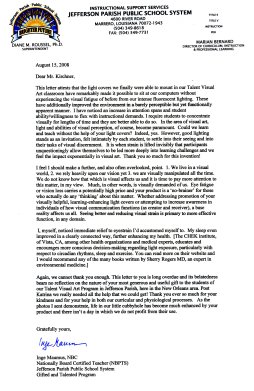 |
||||
|
Besides teachers and students, the most important ingredient in any classroom is proper lighting.
NaturaLux™ Filters not only create a visually soothing environment in the classroom, they also serve to stimulate a student's visual abilities as well. There have been numerous studies which indicate that when a light source leans more to the bluer spectra of visible light, the brighter that light appears to the visual system. Also, if that light source also happens to create color-corrected illumination, the teachers and students both benefit from the full spectrum of light in the classroom. It's almost like being outdoors! To better illustrate this point, here is a study that was performed by Sam Berman, PhD and Dr. Mojtaba Navvab, PhD, et al. This study shows that students under higher color temperature (5000K, bluer) light had improved visual acuity for visual tasking in the classroom. The study also showed that when compared with warmer (3500K, orange) color temperature light, the schools could save on up to 50% on their lighting bill. Here is another study by Berman and Navvab that further establishes their claims. How Does This Happen? There is a very small, but crucial gland in our midbrain called the pineal gland. This little gland is responsible for regulating two very important hormones in our bloodstream: Serotonin and Melatonin. Serotonin is responsible for keeping us alert, awake and aware. Melatonin is responsible for making us sleepy, drowsy and relaxed. We need both of these hormones in our blood during the course of the day to establish our "circadian rhythm" or "sleepy - wakey" cycle. As an educator, would you rather instruct a group of wide-eyed, alert and attentive students, or a group of tired, lethargic students who can barely keep their eyes open? The answer is obvious. A group of specialists at the Department of Neurology, Thomas Jefferson University in Philadelphia, Pennsylvania discovered a new photoreceptor in the retina of the human eye. Unlike cones that provide us with day, color, and central vision or rods that give us night, black and white and peripheral vision, these new photoreceptors have NOTHING to do with vision at all. Their sole purpose is to inform the brain when it is either day or night. It turns out that this new photoreceptor is especially sensitive to the blue-green spectra of visible light. When this photoreceptor is stimulated, it instructs the pineal gland to release more serotonin, which in turn makes us more awake and alert in the classroom. Testimonial Letter from a Teacher in Jefferson Parrish, Louisianna
The Safest, Most Effective Solution... All NaturaLux™ Filters offer the following features:
NaturaLux™ Filters: Making Classroom Instruction Easier and Safer
Copyright © 1999-2018 Kevin A. Kirschner All rights reserved |
||||
